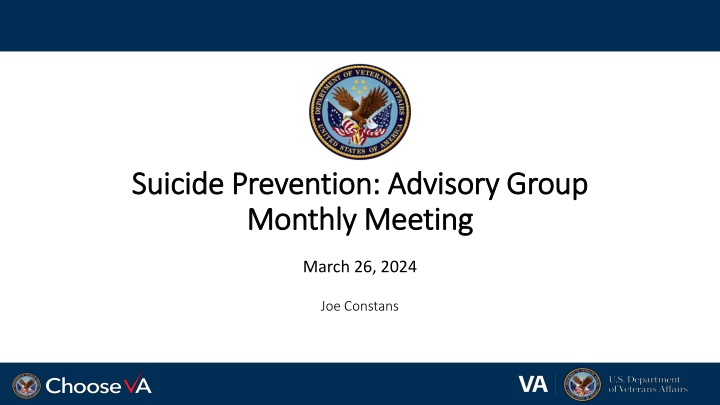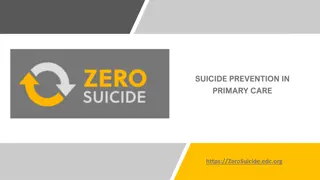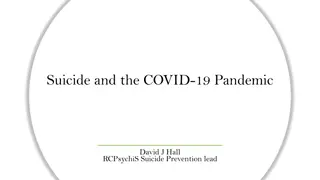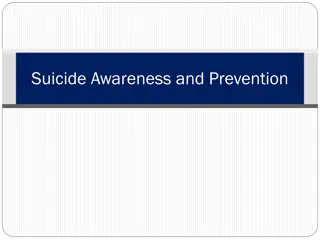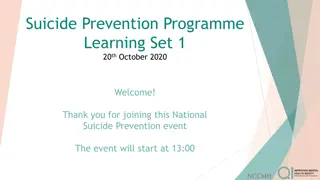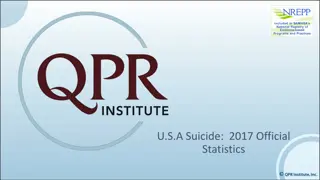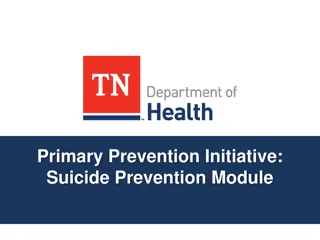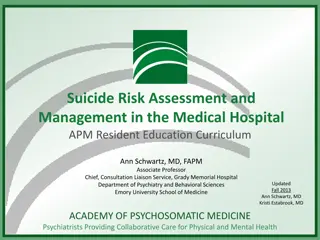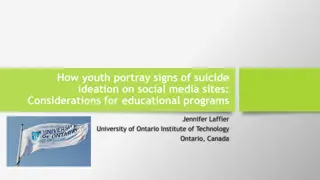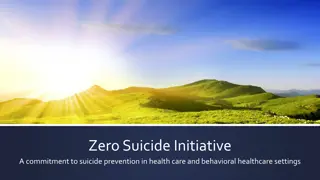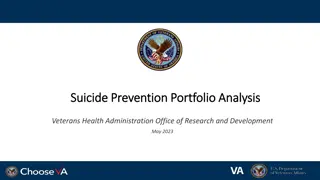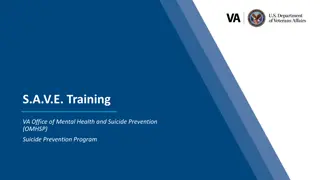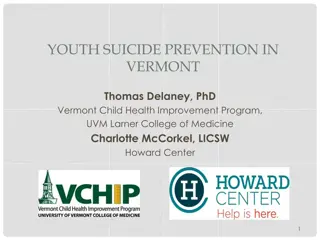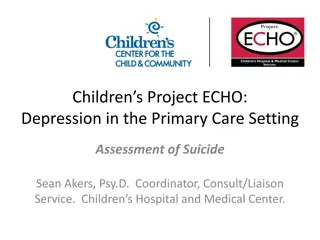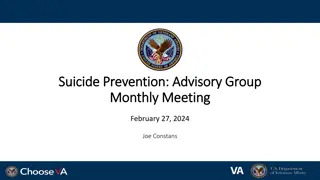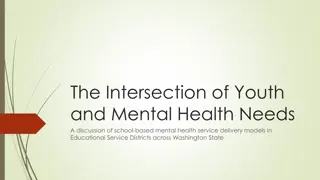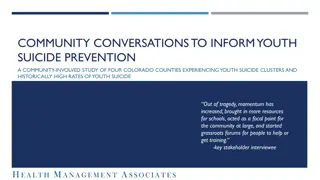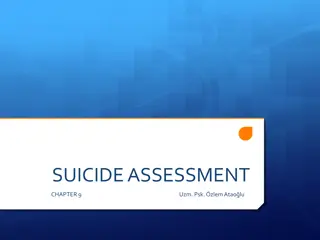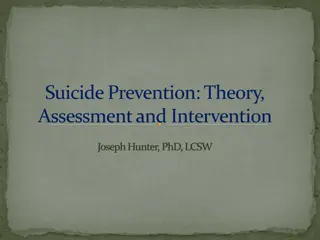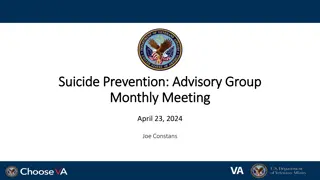Suicide Prevention Advisory Group Monthly Meeting - March 26, 2024
Advisory Group meeting agenda includes SME recommendations, portfolio reorganization, AMP development, priority setting, and more. Discussion on survey data, priority survey results, and next steps.
Download Presentation

Please find below an Image/Link to download the presentation.
The content on the website is provided AS IS for your information and personal use only. It may not be sold, licensed, or shared on other websites without obtaining consent from the author.If you encounter any issues during the download, it is possible that the publisher has removed the file from their server.
You are allowed to download the files provided on this website for personal or commercial use, subject to the condition that they are used lawfully. All files are the property of their respective owners.
The content on the website is provided AS IS for your information and personal use only. It may not be sold, licensed, or shared on other websites without obtaining consent from the author.
E N D
Presentation Transcript
Suicide Prevention: Advisory Group Suicide Prevention: Advisory Group Monthly Meeting Monthly Meeting March 26, 2024 Joe Constans
Agenda Agenda Time Item Objective SME recommendations for these domains SME questions Establish date for SP AMP Consensus Panel Review next steps in priority development Discuss portfolio reorganization in ISRM Review portfolio purview statement Review priority setting process 3:00 3:05 Review AMP Development Review aggregate survey data from SPRINT, CMHOs, VEC Discuss themes of results 3:05 3:35 Results from Priority Survey 3:35 3:45 Discussion Questions 3:45 3:50 Next Steps
ORD Reorganization and Development of a Suicide Prevention AMP 3
Portfolio Stand Portfolio Stand- -up Progress up Progress Based on the Suicide Prevention workplan, the team plans to complete the designated documents by the end of these months. November May 2024 May - June 2024 Completed In Progress Future Items Role Charter Executive Committee Charter Purview Statement Portfolio Analysis Report Portfolio Analysis PPT Position Description Portfolio Performance Metrics Critical Research Priorities Program Announcements Funding Model SOP
Last Meeting Recall: Rapid (and Rigorous) Approach to Identifying AMP Research Priorities Last Meeting Recall: Rapid (and Rigorous) Approach to Identifying AMP Research Priorities Survey and focus group input inform Delphi consensus panel discussion with representatives from different groups Phase II: Refine Priorities using concurrent processes: national surveys/live voting & focus groups with Consumer, Provider, Leader, Investigator groups Existing reviews inform focus group, survey questions Phase I: Identify research gaps and unanswered questions (e.g., SPM review, evidence inventories or reviews, VA program office strategic plans) Phase III: Delphi consensus panel with interested party representatives rank priorities on urgency, impact, feasibility, identify impact metrics Current Phase AMP Priorities for RFA General principles: 1. Priorities should reflect the research translation spectrum (e.g., T1-T4) 2. In-depth feedback from focus groups to identify topics not previously listed 3. Broad representation across interested parties via surveys, voting on top priorities 4. Perspectives from the front line References: 1. Aligning quality improvement efforts and policy goals in a national integrated health system - Braganza - 2022 - Health Services Research - Wiley Online Library; 2. Health System Research Priorities for Children and Youth With Special Health Care Needs - PubMed (nih.gov), 3. Research Lifecycle to Increase the Substantial Real-world Im... : Medical Care (lww.com) Measures of Impact Exec. Committee
Phases to determine Critical Research Priorities Phases to determine Critical Research Priorities 1. Reviewing existing literature around suicide prevention research priorities 2. Refining the collected priority list by conducting surveys and discussing priority topics with focus groups. Ranking of topics using structured survey. 3. Holding a consensus panel with the portfolio s executive committee to review priorities and rank based on urgency, impact, and feasibility Braganza, M. Z., Pearson, E., Avila, C. J., Zlowe, D., vretveit, J., & Kilbourne, A. M. (2022). Aligning quality improvement efforts and policy goals in a national integrated health system. Health Services Research, 57, 9-19.
Suicide Prevention Discussion Groups: Qualitative Data 7
Phase 2: Gathering input from various stakeholders Phase 2: Gathering input from various stakeholders Priority Questionnaire Distribution to Field (November 17, 2023) A survey was sent out to investigators within the SPRINT database. We collected responses from 54 respondents, each listing ranked research priorities. These priorities were coded into the categories developed in Phase 1. Veteran s Engagement Council Discussion (December 7, 2023) Our team met with a Veteran s Engagement Council in December to hold a discussion and gather research topics of interest to veterans. VISN Suicide Prevention Lead Open Discussion (January 11, 2024) Understanding Research Priorities from the perspective of VISN Leads for Suicide Prevention Coordinators. Discussion with VA Investigators (January 19, 2024) Discussion of qualitative data obtained and solicitations of recommendations for quantitative survey. Discussion with CMHO (March 25, 2024) Discussion of survey data, differences in between respondent groups.
Phase 2: Veterans Engagement Council Discussion Phase 2: Veteran s Engagement Council Discussion Key Questions for Audience: Research Priorities Discussed during Meeting Hard to Reach Veterans (Isolating Veterans/ Veterans not in VA care/ Rural Veterans / Transitioning to civilian) Continuity of Care* Community Research (including family) Developing Novel Treatments (including provider perspective) Moral Injury/Spiritual Lethal Means Safety Messaging Peer Support Messaging Data Studies Racial/Ethnic/Sexual Minorities Brain/TBI/Genomics 1. What suicide prevention research topics come to mind as most important for Veterans from your perspective? 2. Are there specific patient populations it would be important to study (if this has not come up)? 3. Are there any research topics you don t think are as high a priority? 4. Are there particular topics within this area that come to mind that would be important for VA researchers to work on? 9 * - category not identified through investigator survey
Phase 2: VISN Suicide Prevention Lead Phase 2: VISN Suicide Prevention Lead Open Discussion Open Discussion Key Questions for Audience: Research Priorities Discussed during Meeting Risk Identification Process* Needs modification Clinician burden too high Clinical Trial Feasibility* Psychotherapy Small trials will not advance practice Community Interventions Education, Training, and Messaging Firearms, Lethal Means Safety Safety Planning Older Veterans Female Veterans 1. What areas in suicide prevention do you think needs more research to support your clinical decision-making? 2. How does your program implement current research evidence or data regarding assessing suicide risk? What would make risk assessment processes or resulting risk information more useful or actionable? 3. How do you use the information you have now regarding effectiveness of suicide prevention interventions and treatments? What new information would help your program make evidence-informed treatment planning decisions? 4. Are there certain patient characteristics that are important to study or to include in VA research? * - priority areas 10
Phase 2: CMHO Phase 2: CMHO Open Discussion Open Discussion Key Questions for Audience: Research Priorities Discussed during Meeting Risk Identification Process* Need to rethink static, universal screening Critical review of Risk ID processes Development of dynamic risk identification processes Reviewed priority setting process and results of survey. Solicited feedback on topic areas. No significant feedback on other * - priority areas (limited discussion) 11
Phase 2: SPRINT Investigators Phase 2: SPRINT Investigators Open Discussion Open Discussion Key Questions for Audience: Research Priorities Discussed during Meeting Survey Content Use of count data Include themes important to non-investigator stakeholders Suggestions regarding weighting of quantitative and qualitative data to identify content domains for consideration? Thoughts on ranking or rating of content domains in the survey? That is, what do you see as the benefits of ranking over rating and visa versa? Recommended different instructions Framing language to define what is meant by important Broad Categories Rate categories Rank top 3 categories Specify what should be studied in top 3 categories How many domains should be considered on the survey? What are the recommendations regarding specificity in the domains in survey? Populations Rank each population 12
Survey Survey Preview
Survey Survey - - Preview Preview 15
Survey Survey - - Preview Preview 16
Survey Survey - - Preview Preview 17
Suicide Prevention Priority Survey Suicide Prevention Priority Survey Distribution Group Survey Response Timeline Responses SPRINT Investigators 2/14 2/23 72 VEC Veterans 2/21 3/04 11 CMHOs 2/28 - 3/13 15 Who responded*? CMHO (15 responses) VEC (11 responses) SPRINT (72 responses) Total (98 responses) 73% 47% 7% 0% 18% 9% 0% 82% 10% 92% 36% 1% 20% 76% 28% 10% Administrator Investigator Clinician Veteran *Respondents could select multiple roles, the columns below will exceed 100% 18
Research Priority Domain Rating Research Priority Domain Rating The weighted results take into account the number of responders in each survey group Average Rating - Unweighted Average Rating - Weighted VEC Rating (11) SPRINT Rating (68) CMHO Rating (15) Domains 3.91 4.3 4.15 4.12 4.23 Lethal Means Safety approaches to suicide prevention 4.36 4.24 3.46 4.02 4.13 Community-based interventions for suicide prevention Psychotherapies and other non-somatic interventions for suicide prevention 3.36 4.18 3.69 3.74 4.01 Family and social network-based interventions and postventions Suicide risk screening, evaluation effectiveness, and processes within VA 4.09 4.07 3.69 3.95 4.01 3.45 3.79 4.62 3.95 3.88 Technology, including wearable devices and text data, to assess for suicide risk and to provide suicide prevention interventions and self-management strategies 3.55 3.51 3.38 3.48 3.49 Educational or messaging offerings to stakeholders (Veterans, community, clinicians, families/peers, etc) 3.73 3.38 2.62 3.24 3.3 Machine-based suicide risk algorithms that utilize large existing data sets to improve risk accuracy or developing precision-medicine approaches to suicide prevention 2.73 3.31 3.62 3.22 3.29 Psychopharmacological and other somatic interventions (e.g., TMS) to prevent suicide Biological mechanisms and genetic contributions to suicide 2.36 3.19 3.62 3.06 3.16 2.91 2.76 3.54 3.07 2.9 19
High Priority Domain Example Studies High Priority Domain Example Studies Domains Selected Free Responses Focus resources on rapidly implementing and assessing the impact of current best practice lethal means safety for suicide prevention. Examining the impact of Lethal Means Safety Counseling Interventions on Behavior (e.g., use of safe storage); examining the impact of LMS programs and distribution of safe storage on suicidal behaviors and death Lethal Means Safety approaches to suicide prevention Suicide risk screening, evaluation effectiveness, and processes within VA Identification of veterans at low to moderate risk who should be targeted through public health approaches, particularly those outside of mental health evaluation of effectiveness of traditional screening within VA. Does filling out a CSSRS impact clinical outcomes Interventions to improve support and helpfulness of family members and professional caregivers in their efforts to support a Veteran at risk for suicide Family and social network-based interventions and postventions We need more work aimed at figuring out the most cost effective approaches for reducing suicide risk through therapy. It's not clear how much CBT-SP does over and above safety planning alone; group format's need to be explored as well as web-based and digital interventions. We need to try to get the interventions that are known to work to as many at risk veterans as possible. Developing novel psychotherapies to address suicide risk and conducting randomized controlled trials to build their evidence base Developing a large network of sites for large multi-site clinical trials. Psychotherapies and other non-somatic interventions for suicide prevention I agree with those who note that VA work must be paired with community interventions to help those who will never enter a VA (the majority of suicides). We know very little in this area. Developing strategies to engage non-VHA users in SP programming at VA including LMS counseling. building collaborations with community partners and leveraging community resources to create shifts/changes in suicide outcomes over the longer term Community-based interventions for suicide prevention 20
Key Priority Areas Key Priority Areas Based on the analysis of the survey results, these 5 areas were deemed to be the key priority areas. Suicide Prevention Portfolio will focus on addressing one or more of these priorities in the coming fiscal years. 1. Lethal Means Safety approaches to suicide prevention 2. Community-based interventions for suicide prevention 3. Family and social network-based interventions and postventions 4. Psychotherapies and other non-somatic interventions for suicide prevention 5. Suicide risk screening, evaluation effectiveness, and processes within VA; predictive analytics The next step in the Critical Research Priority setting process encourages us to determine what are the specific gaps in research within these domains that we can plan to address.
Next Steps 22
SME Suggestions SME Suggestions Lethal Means Safety Community-Facing SP Research Psychotherapies Research Family and social network-based interventions and postventions Suicide risk screening, evaluation effectiveness, and processes within VA; predictive analytics* Ian Stanley (VA WOC) Bryann DeBeer (VA) Peter Britton (VA) Marianne Goodman (VA) Nasi Bahraini (VA) Emmy Betz (non-VA) Monica Matthieu (VA) Craig Bryan (VA) BryAnn Debeer (VA) Steve Dobscha (VA) Joe Simonetti (VA) Gala True (VA) Greg Brown (non-VA) Alan Teo (VA) Ron Kessler (non-VA) Mike Anestis (non-VA) Peter Wyman (non-VA) David Rudd (non-VA) Jason Chen (VA early career but has done work on social networks and post vention; also disparities) Rob Bossarte (VA) Steve Dobscha (VA) Marianne Goodman (VA) Ken Connor (high risk and SUD; non-VA) Bridget Matarazzo (VA) Cathy Barber (non-VA) Ray Tucker (non-VA) Kim Van Orden (older adults; non-VA) Greg Simon (non-VA) Matthew Miller (non-VA) Kate Comtois (non-VA) Lisa Brenner (VA) Sean Barnes (VA) Nate Kimbrell (VA) Mark Ilgen (VA) Plan: Select 5 (3 VA / 2 non VA); move down list if no response Alex Interian (VA) David Rozek (non-VA) 23 *Additional recommendations submitted by Drs. Strickland and Villareal
SME Questions SME Questions Based on your knowledge of the state of the science, can you identify 1 to 3 research questions that would be especially important to answer and/or key next steps within the overall topic domain of XYZ? What type of research strategies would best help to answer these research questions? For example, do you believe that advancement would be best realized through clinical trial research, implementation science investigations, development of novel interventions, or improve understanding of the mechanisms through which this topic area is associated with suicide? In considering your response above, do you believe that organizations should prioritize funding smaller numbers of large trials to improve confidence in existing findings or more numerous smaller investigations that may lead to improved or novel strategies? What type of professional expertise is required for the study teams to pursue the research that you are recommending? Anything else? 24
Consensus Panel Discussion Consensus Panel Discussion Collection and Analysis of SME Responses Presentation of results in April to Advisory Group Looking to determine a date for voting Tuesday May 21st ??????? Department of Veterans Affairs Office of Research & Development Wendy Tenhula (CRADO), ORD, Dept. of Veterans Affairs David Atkins Former Director, HSR&D, Dept. of Veterans Affairs, VA WOC employee Kara Beck QUERI Representative, ORD, Dept. of Veterans Affairs VHA Stakeholders Jodi Trafton Constituency Member Constituency Director, VA Program Evaluation and Resource Center Deputy Chief Research and Development Officer Voting Member Bradley Watts Research Director, VHA Office of Rural Health Member Voting Member Voting Member Department of Veterans Affairs Office of Mental Health and Suicide Prevention Matt Miller Director, Suicide Prevention, Office of Mental Health and Suicide Prevention Susan Strickland Mental Health and Suicide Prevention Edgar Villareal National Clinical Director, Office of Mental Health and Suicide Prevention External Federal Funding Agency Stephen O Connor Melissa Mehalick Constituency NIH Representative Voting Member Voting Member DoD Representative Voting Member Director of Research Coordination, Office of Voting Member Voting Member 25
Discussion 26
Appendix 27
High Priority Domain Ranking High Priority Domain Ranking Aggregate No. 1 Rankings VEC Ranking (incomplete)* SPRINT Ranking CMHO Ranking Aggregate Ranking Domains Lethal Means Safety approaches to suicide prevention Community-based interventions for suicide prevention Psychotherapies and other non-somatic interventions for suicide prevention Family and social network-based interventions and postventions Suicide risk screening, evaluation effectiveness, and processes within VA Weighted Methods: - A Ranking of 1 gives the domain a score of 10, down to a Ranking of 10 gives the domain a score of 1. Combining all rankings across all responses results in these overall ranks. 12 20 342 29 391 6 18 467 19 504 14 7 350 35 392 4 374 0 374 2 138 31 169 Technology, including wearable devices and text data, to assess for suicide risk and to provide suicide prevention interventions and self-management strategies Educational or messaging offerings to stakeholders (Veterans, community, clinicians, families/peers, etc) 0 209 15 224 Recommend collapsing this domain into suicide risk screen based on feedback from SPC Leads and CMHO 1 9 57 0 66 Machine-based suicide risk algorithms that utilize large existing data sets to improve risk accuracy or developing precision- medicine approaches to suicide prevention Psychopharmacological and other somatic interventions (e.g., TMS) to prevent suicide Biological mechanisms and genetic contributions to suicide 3 9 145 19 173 1 200 17 217 3 72 17 89 28
